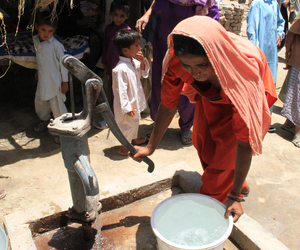
Drinking arsenic-contaminated water leads to a series of health problems that has limited development for the largely poor rural people of Pakistan who are unable to afford bottled water, centralized treatment plants or expensive water filter systems. This paper reviews the available appropriate technologies for the removal of arsenic from drinking water to assist in just sustainable development in Pakistan. Several technologies were found to be both technically and economically viable, supporting the large-scale deployment of these small-scale, appropriate technologies. The economic viability determined in this study was based on both first costs and operating costs. The cost of implementing such technologies for an individual Pakistani family is made acceptable with the use of local materials, which the family may already own. For example, systems using sand and iron nails in the filters, and that are placed in plastic buckets that are already in common use in the villages, drive down the overall costs of the technology and put it in the reach of even the most destitute. This study found that complications from the variability of local supplies result in the need to identify the locally most appropriate solution from both a technical and economic standpoint. This review article should be helpful for any practitioner in determining the locally optimal solution for the removal of arsenic from drinking water in Pakistan.
- Fatima Hashmi and Joshua M. Pearce, "Viability of Small-Scale Arsenic-Contaminated Water Purification Technologies for Sustainable Development in Pakistan", Sustainable Development, 19(4), pp. 223-234, 2011. Open access pre-print, DOI
Summary table[edit | edit source]
References[edit | edit source]
- Berkeley Arsenic Alleviation Group (BAAG). 2007b. Cost Effective Method for Removing Arsenic from Water.Available Technologies. Retrieved on October 28th, 2007, from Berkeley Lab Web site: [1]
- Eriksen-Hamel N, Zinia BKN. 2001. A study of arsenic treatment technologies and teaching the characteristics of arsenic contaminated sludge, In: M. Feroze Ahmed. et al. 2001 (Eds). Technologies for Arsenic Removal from Drinking Water. Bangladesh University of Engineering and Technology:Dhaka, Bangladesh and the United Nations University: Tokyo.
- Hurd J.J. 2001. Evaluation of three arsenic removal technologies in Nepal. Masters of Engineering thesis. Massachusetts Institute of Technology: Cambridge, Massachusetts.
- Hussam A. Munir A. 2007. A simple and effective arsenic filter based on composite iron matrix: Development and deployment studies for groundwater of Bangladesh. Journal of Environmental Science and Health. Part A 42:1869–1878.
- Hwang K.S. Point of use of arsenic removal from drinking water in Nepal using coagulation and filtration. Thesis, Massachusetts Institute of Technology: Cambridge, Massachusetts.
- Munir A.K.M. Rasul S. B. Habibuddowla M. Alauddin M. Hussam A. Khan A. H. 2001. Evaluation of the Performance of the SONO3-Kolshi Filter for Arsenic Removal from Groundwater Using Zero Valent Iron Through Laboratory and Field Studies. Proceedings International Workshop on Technology for Arsenic Removal from Drinking Water, Bangladesh University of Engineering and Technology and United Nations University, Japan, May 5, pp. 171–189.
- Ngai T. Dangol B. Murcott S. Shrestha R.R. 2006. Kanchan Arsenic Filter (KAF). Massachusetts Institute of Technology (MIT) and Environment and Public Health Organization (ENPHO): Kathmandu, Nepal.
- Pearce J.M. Denkenberger D.C.. 2006. Numerical Simulation of the Direct Application of Compound Parabolic Concentrators to a Single Effect Basin Solar Still. Proceedings of the 2006 International Conference of Solar Cooking and Food Processing. 118. open access full text pdf
- Tabbal G. 2003. Technical and social evaluation of 3 arsenic removal technologies in Nepal. Masters of Engineering Thesis. Massachusetts Institute of Technology: Cambridge, Massachusetts.
- Tahir M.A. 2004. Assessment of Arsenic and other health significant water quality parameters in groundwater of Northern Punjab. Ph.D. Thesis. Department of Chemistry Bahuddin Zakariya University:Multan, Pakistan.
